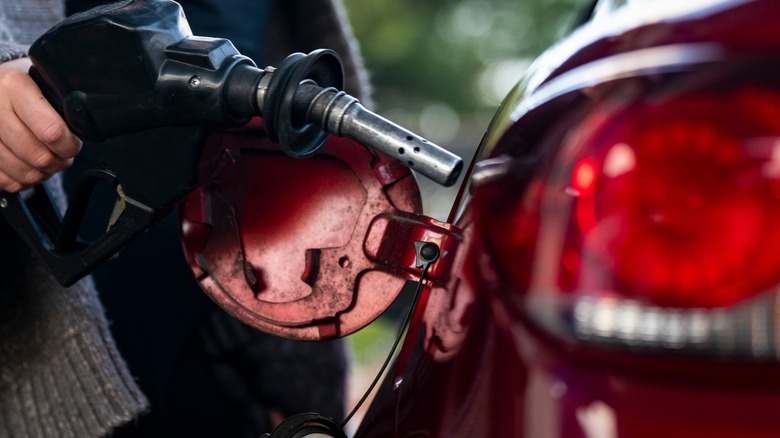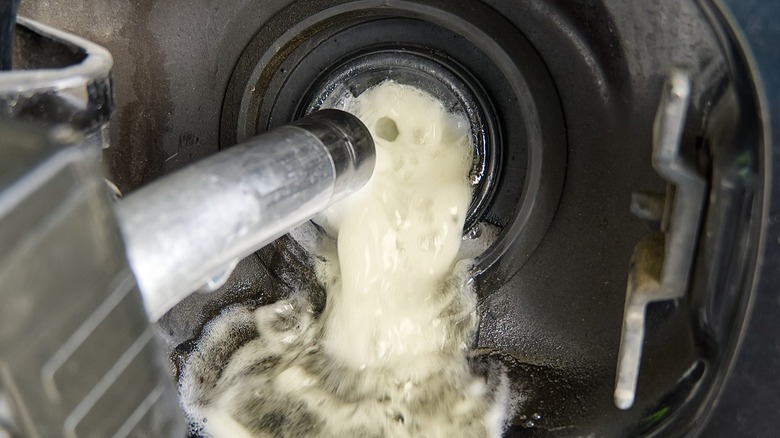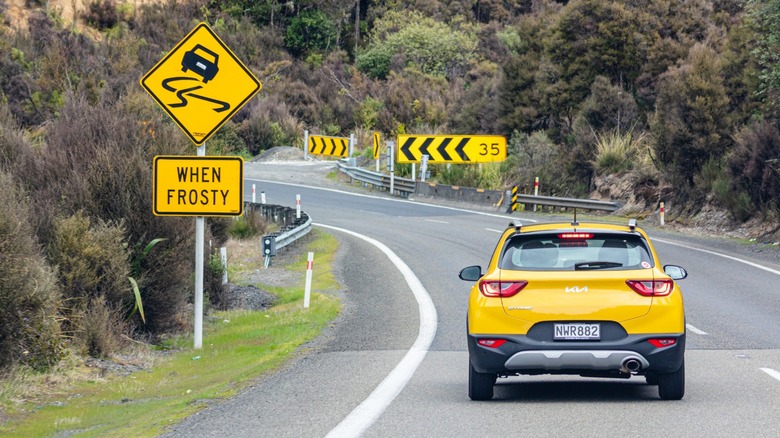Topping Off Your Gas Tank Is A Huge Mistake - Here's Why
Topping off your car's tank is a very common practice. However, those who have done it may not have given enough consideration to the possible risks that it brings. It's not the worst thing you could do to your car, but there are plenty of reasons why you may want to reconsider doing it in the future.
To be clear, by topping off, we're referring to filling your car's tank more than the manufacturer recommends by bypassing the system designed to keep this from happening. Many gas pump fuel nozzles have an automatic shut-off that prevents overfilling, but you can bypass this and add more fuel to the point where you're also filling up the fuel filler neck.
This can result in the fuel overflowing out of the tank when you go around corners. That's not only wasteful but depending on where the tank is located in the vehicle, fuel can spill onto the car's hot exhaust and cause a fire, especially if it runs on gasoline. Diesel vehicles are safer in this respect, as the fuel itself is far less likely to be ignited by high temperatures—you can throw a lit match into a puddle of diesel and it will simply go out.
Filling up to the brim also means you're carrying around extra weight, which will incur a small fuel efficiency penalty. The additional weight will also affect handling, and in vehicles with bigger tanks, you may feel the fuel sloshing around, altering the car's trajectory through corners.
Fuel Tanks Are Not Designed To Be Brimmed
There are many reasons why automakers don't want you to fill a car's tank to the brim, especially if it runs on gasoline. The fuel system has valves that serve the purpose of controlling the pressure caused by the buildup of gasoline vapors. But if you fill the tank more than you should, these could be blocked with fuel, and this can cause damage.
These valves are also designed to prevent the formation of a vacuum in the fuel system since this too can cause the vapor recovery system to fail, which will, in turn, result in a check engine light appearing on the dash, and it may even cause your engine to shut down while driving. Overfilling can also result in damage to the charcoal canister (also known as the EVAP canister), whose role is to capture vapors, purge the system, and help keep emissions within spec.
If the evaporative emissions system malfunctions, this can even lead to fuel vapors traveling through the system with the potential to even reach the vehicle's exhaust system. This will affect emissions (to the point where your vehicle may fail a technical inspection), it will hurt fuel efficiency, and it could even cause damage to the catalytic converter (which will further affect emissions).
Unburnt fuel vapors from the fuel system passing through the engine will also increase wear over time, thus requiring more maintenance than would be needed otherwise. These stray vapors can even affect a vehicle's oxygen sensor, potentially causing it to run rough or burn more fuel than necessary. All this affects emissions and performance, and it will ultimately lead to you spending more money to keep your car running and deriving less enjoyment from its ownership.
Sloshing Can Be Dangerous
If you drive a vehicle with a big fuel tank that you have just brimmed, and then you go for a spirited drive around a twisty road, you will certainly notice the effect of all that fuel sloshing around the tank. The more liquid there is, the more inertia it will have as it sloshes around, and if it all sloshes at once, you may feel it as light thumps coming from wherever it is located in the vehicle (usually in the rear section).
On some vehicles, the tank is located behind the rear axle, and if it's full, its extra weight combined with the aforementioned sloshing could act like a pendulum. In some instances (usually prompted by low-grip conditions), the pendulum effect can be so bad that it could result in the rear tires losing grip and potentially sending the vehicle off the road and into a ditch.


